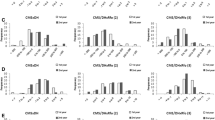Summary
The reliability of a selection among crosses based on a cross prediction in early generations was investigated in spring rapeseed. The performance of the parents, the F2 generation, and random F3 lines from four crosses were used to predict the probability of finding superior recombinant lines. These predictions were made for two years and compared with the observed performance of F6 lines in the second of these two years and in an additional year. Predicted and observed performances coincided reasonably for the characters plant height, standability, maturity and an index calculated from seed yield, oil content and protein content. For seed yield and flowering time, the predictions were very unreliable. In conclusion, prediction methods may be useful in rapeseed breeding, if quality traits are of major commercial interest.
Similar content being viewed by others
References
Caligari, P.D.S., W. Powell & J.L. Jinks, 1985. The use of double haploids in barley breeding. 2. An assessment of univariate cross prediction methods. Heredity 54: 353–358.
Engqvist,G.M. & H.C.Becker, 1991a. Relative importance of genetic parameters for selecting between oilseed rape crosses. Hereditas 115: 25–30.
Engqvist,G.M. & H.C.Becker, 1991b. Heterosis and epistasis in rapeseed estimated from generation means. Euphytica 58: 31–35.
Engqvist,G.M. & H.C.Becker, 1993. Correlation studies in segregating families of spring oilseed rape (Brassica napus). Hereditas 118: 211–216.
Jinks,J.L. & H.S.Pooni, 1976. Predicting the properties of recombinant inbred lines derived by single seed descent. Heredity 36: 253–266.
Mather,K. & J.L.Jinks, 1982. Biometrical Genetics. 3rd ed. Chapman and Hall, London.
Oeveren,J.van, 1992. A comparison between single seed descent and early cross selection in wheat breeding. II. The evaluative generations. Euphytica 64: 91–97.
Ooijen,J.W.van, 1989. The predictive value of quantitative genetic parameters in autogamous crops: Bias caused by intergenotypic competition. 2. F∞ variance. Euphytica 44: 95–108.
Pooni,H.S. & J.L.Jinks, 1978. Predicting the properties of recombinant inbred lines derived by single seed descent for two or more characters simultaneously. Heredity 40: 349–361.
SAS Institute, Inc., 1990. SAS user's guide, statistics, version 5edn. SAS Institute, Inc., Carey/NC.
Snape,J.W., 1982. Predicting the frequencies of transgressive segregants for yield and yield components in wheat. Theor. Appl. Genet. 62: 127–134.
Swanston,J.S., R.P.Ellis, W.T.B.Thomas & N.L.Innes, 1987. Barley breeding at the Scottish Crop Research Institute. Barley Genetics 5: 955–960.
Thomas,W.T.B., 1987. The use of random F3 families for cross prediction in spring barley. J. Agric. Sci. Camb. 108: 431–436.
Werner,C.P., A.P.Setter, B.M.Smith, J.Kubba & M.J.Kearsey, 1989. Performance of recombinant inbred lines in Brussels sprouts (Brassica oleracea var. gemmifera). Theor. Appl. Genet. 77: 527–534.
Author information
Authors and Affiliations
Rights and permissions
About this article
Cite this article
Engqvist, G.M., Becker, H.C. Prediction of F6 line performance from F3 families in spring oilseed rape. I. Yield and other agronomic traits. Euphytica 69, 141–147 (1993). https://doi.org/10.1007/BF00021738
Received:
Accepted:
Issue Date:
DOI: https://doi.org/10.1007/BF00021738



